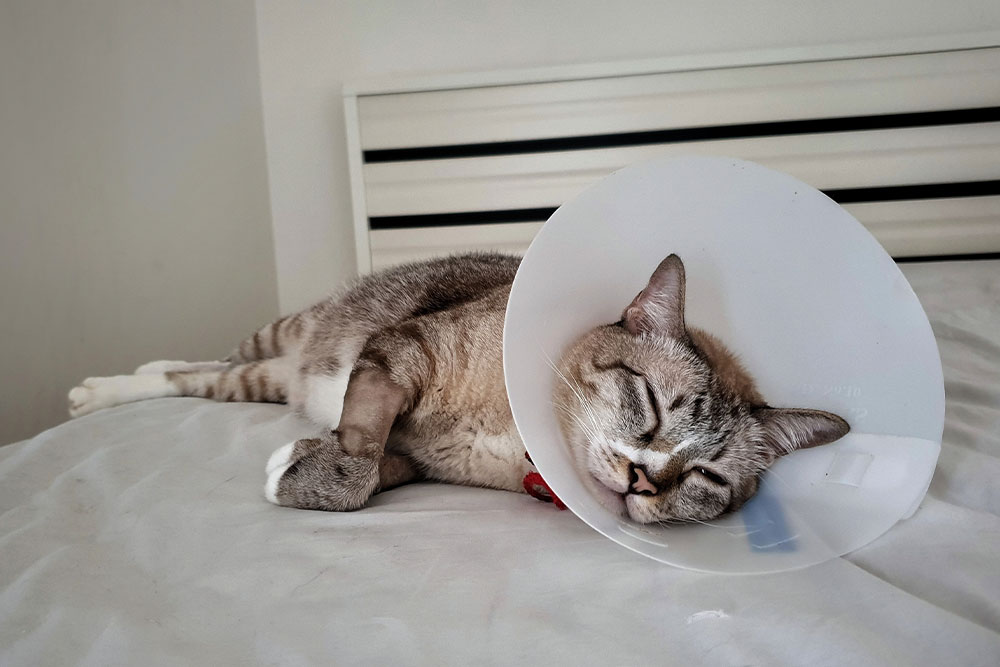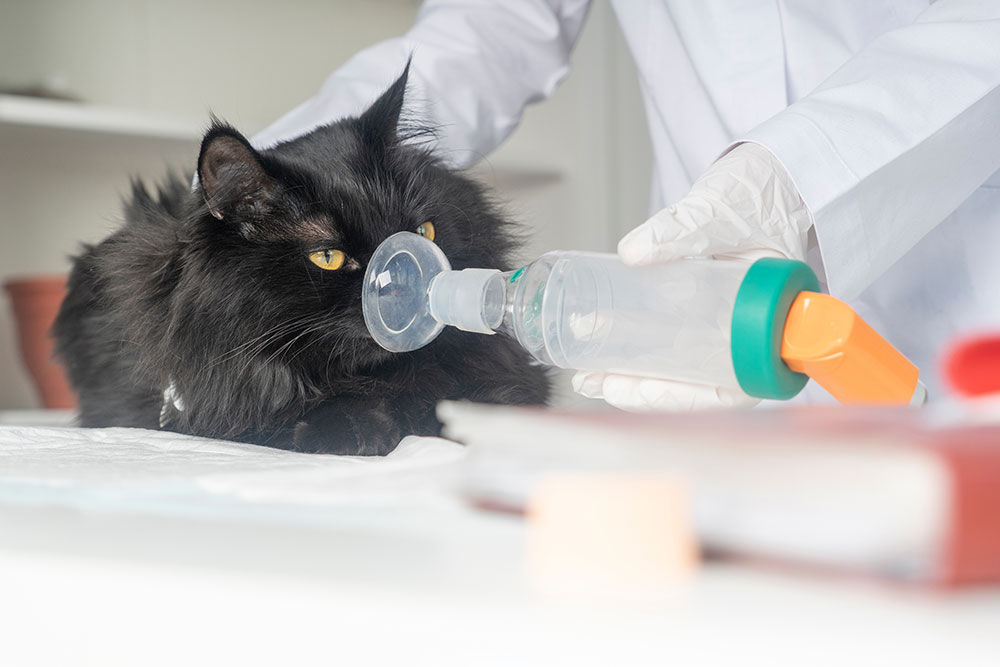Comprehensive Guide to Feline Asthma for Cat Owners
Feline asthma is a more common ailment than most might expect, affecting an estimated 1-5% of all cats. Here in Ohio, where environmental factors like seasonal allergens can exacerbate symptoms, understanding this chronic respiratory condition is crucial for cat owners. This guide provides an in-depth look at feline asthma, from symptoms and diagnosis to management and prevention.
What is Feline Asthma? Understanding the Basics
Feline asthma, similar to human asthma, is a chronic inflammation of the small passageways in a cat’s lungs. When these airways become inflamed and constricted, it leads to difficulty breathing and other respiratory complications. Without timely intervention, this condition can progress, causing irreversible lung damage and severely impacting a cat’s quality of life.
Causes of Asthma in Cats
- Allergens: Pollen, dust, mold, and household cleaning agents can trigger asthma. This is particularly concerning during Westerville’s high-pollen seasons in spring and fall. Indoor allergens such as dust mites and mold spores are also significant contributors. Pet owners should be vigilant about seasonal changes and adjust their home environment accordingly to mitigate exposure.
- Smoke: Exposure to cigarette smoke or wood-burning stoves can provoke asthma symptoms in cats. It’s important for pet owners to ensure a smoke-free environment to prevent exacerbation of symptoms.
- Obesity: Overweight cats are at a higher risk for developing asthma due to the increased respiratory effort needed to breathe. Maintaining a healthy weight through a balanced diet and regular exercise is crucial in preventing and managing asthma.
Recognizing the Symptoms of Asthma in Cats
Identifying the signs of asthma early can lead to a quicker diagnosis and better management of the condition. However, symptoms can vary in severity, and recognizing them promptly can prevent complications.
Early Signs
- Coughing and Wheezing: These are typical early indicators. A cough in cats sounds more like a forced exhale and may be mistaken for hairball-related coughing. Persistent wheezing, especially during physical activity or stress, often signals the presence of asthma.
- Difficulty Breathing: Watch for increased effort in breathing, which might include heaving sides. Cats may also exhibit open-mouth breathing, an unusual behavior for felines.
Severe Symptoms
- Rapid Breathing: Also known as tachypnea, this may occur if your cat is struggling to get enough oxygen. The normal respiratory rate for a resting cat is about 20-30 breaths per minute; anything above this range could indicate distress.
- Lethargy and Blue Lips/Gums: These are signs of oxygen deprivation and require immediate veterinary attention. Cyanosis (blue-tinged lips and gums) indicates a severe lack of oxygen and can be life-threatening.
Behavioral Changes
- Reduced Activity Levels: Cats with breathing difficulties may avoid exertion. They might be less interested in play or appear fatigued after minimal effort.
- Hiding: Cats often hide when they’re in distress or not feeling well. This behavior can indicate discomfort or fear related to breathing difficulties.
Diagnosing Asthma in Cats: What to Expect at West Vets Emergency Veterinary Clinic
When you bring your cat to our clinic, here’s what you can expect:
Initial Vet Visit
- Preparation: Bring your cat’s medical history and be prepared to discuss their symptoms and any potential triggers at home. Your observations about changes in behavior or environment can be invaluable in narrowing down potential causes.
Diagnostic Tests
- X-rays: These are critical to visualize the condition of the lungs and airways. X-rays can help identify changes such as bronchial thickening or hyperinflation of the lungs, suggestive of asthma.
- Blood Tests: These can help rule out other conditions that might mimic asthma. In some cases, blood tests might reveal elevated levels of eosinophils, a type of white blood cell associated with allergic reactions.
For more specific information on our diagnostic services, visit our West Vets Emergency Veterinary Clinic Services.
Managing Your Cat’s Asthma: Effective Strategies and Treatments
Daily Management Tips
- Avoid Triggers: Keep your home free of smoke and use hypoallergenic bedding and air filters. Regularly replacing air filters can significantly reduce airborne allergens.
- Weight Management: Ensure your cat maintains a healthy weight to reduce respiratory stress. Consult with your veterinarian about a suitable diet plan that supports weight loss or management.
- Stress Reduction: Keep your cat’s environment calm as stress can exacerbate asthma symptoms. Consider creating quiet, cozy spaces where your cat can relax undisturbed.
Medical Treatments
- Inhalers and Corticosteroids: These are often prescribed to help reduce inflammation and open airways. Inhalers designed for cats, such as those used with a spacer mask, deliver medication directly to the lungs, minimizing systemic side effects.
- Bronchodilators: These may be used for quick relief during an asthma attack. They work by relaxing the muscles around the airways, making breathing easier.
Regular veterinary check-ups are essential to monitor your cat’s response to treatment and make any necessary adjustments. For additional insight on managing asthma, consider visiting Asthma in Cats – iCatCare.
When to Seek Emergency Care for Your Asthmatic Cat
Symptoms That Require Immediate Attention
- Severe Respiratory Distress: If your cat is struggling to breathe or stops breathing. Signs include open-mouth breathing, pronounced abdominal effort, and audible wheezing.
- Persistent Coughing: Especially if your cat is unable to rest due to coughing fits. This could indicate an acute asthma attack requiring immediate intervention.
In emergencies, swift action can mean the difference between recovery and a dire outcome. Always have our contact information handy: West Vets Emergency Contact Information.
Preventing Asthma Flare-ups in Cats: Tips and Tricks
Home Environment Modifications
- Air Purifiers: These can help remove allergens from the air. Consider using HEPA filters, which are effective at capturing small particles like pollen and dust mites.
- Regular Cleaning: Vacuum and dust regularly to minimize dust and dander. Use vacuums equipped with HEPA filters and non-toxic cleaning products to reduce potential irritants.
Diet and Exercise
- Balanced Diet: Feed high-quality cat food that supports overall health. Nutrient-rich diets can help strengthen your cat’s immune system and reduce inflammation.
- Regular Activity: Encourage gentle play to keep your cat active without overexertion. Interactive toys and puzzles can stimulate your cat mentally and physically, promoting a healthy lifestyle.
Implementing these strategies can help reduce the frequency and severity of asthma flare-ups in your cat, enhancing their quality of life.
Additional Resources for Cat Owners
For a broader understanding of respiratory issues in pets, read Respiratory Distress in Pets – AAHA.

FAQs About Feline Asthma
Q: Can feline asthma be cured?
A: While there is no cure for feline asthma, it can be effectively managed with proper treatment and lifestyle adjustments.
Q: How often should I take my asthmatic cat to the vet?
A: Regular check-ups every 6-12 months are recommended, but more frequent visits may be necessary if your cat’s condition is unstable or requires medication adjustments.
Q: What should I do if my cat has an asthma attack?
A: Remain calm, move your cat to a quiet area, and administer any prescribed rescue medication. Contact your veterinarian immediately for further instructions.
Your Partner in Managing Feline Asthma
At West Vets Emergency Veterinary Clinic, we are dedicated to providing comprehensive care for your cat’s asthma. We understand the challenges you face and are here to support you with high-quality care and advice. Our team is committed to working with you to create a personalized management plan for your cat, addressing both immediate needs and long-term health goals. If you have concerns about your cat’s respiratory health, don’t hesitate to contact us or visit our clinic.







Leave A Comment